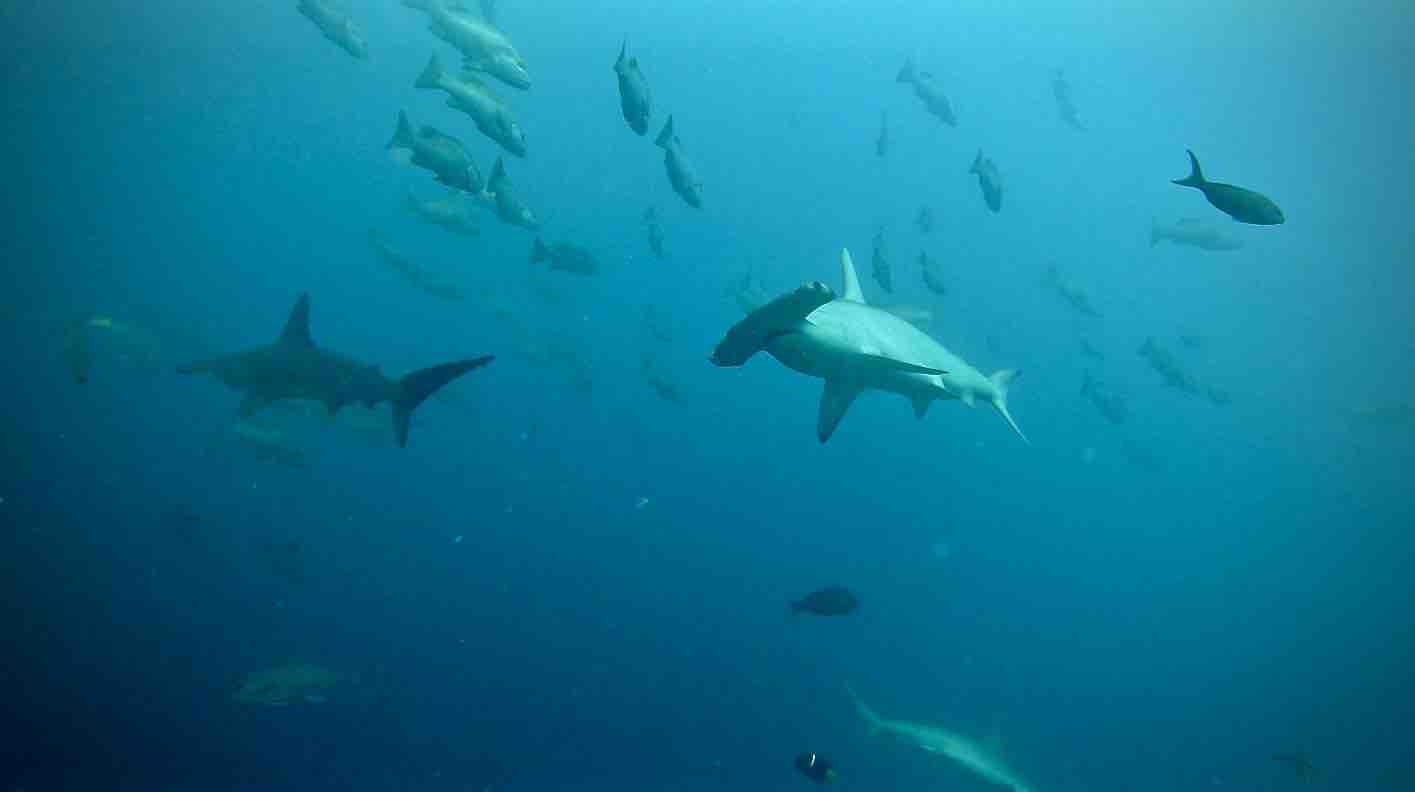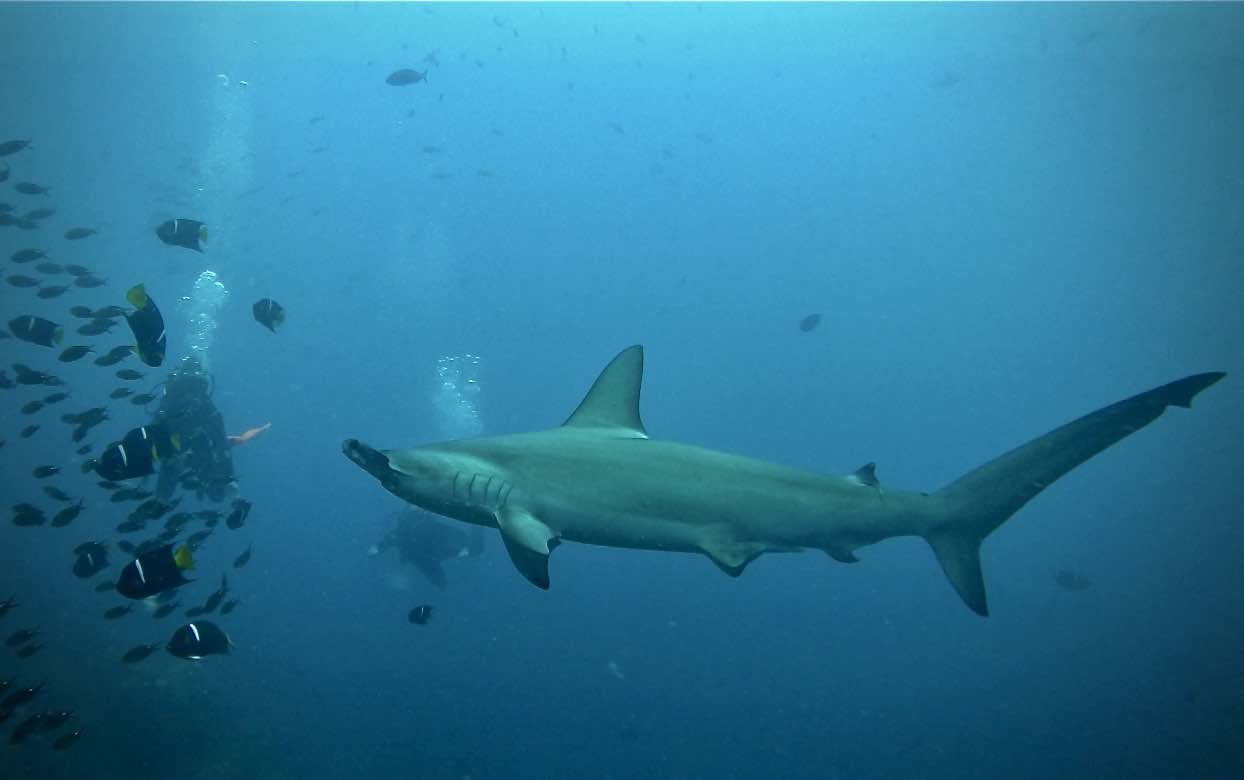There are 9 species of hammerhead sharks that can vary in size from approximately 1 meter to 6 meters in length; they are found in almost all oceans, in temperate or warm waters, mainly in coastal areas. At the Galapagos Islands lives the species: Scalloped Hammerhead, Sphyrna Lewini.
CHARACTERISTICS
One of their main characteristics is the T-shaped head, we still don't know why, but it gives them a certain advantage because of the position of its large eyes that allows them to have a 360 vision, which means they can see above and below them at the same time; this capacity allows them to find their food more easily. In addition, a hammerhead shark has a good structure of its vertebrae which allows it effective movements when it comes to getting food.
Its nostrils are located at the tip of its head extension, its mouth is relatively small and is equipped with serrated teeth and is located just at the center of the bottom of the head; its body has a counter coloration useful for camouflage with the sea floor, while the ventral part is a light tone, the dorsal area has a light gray or greenish.
Another curious feature is that hammerheads are equipped with 7 senses: apart from touch, hearing, smell, sight and taste, they also have one sense that allows them to detect frequency waves caused by the movement of fish, and another that allows them to detect electrical fields, to find prey hidden or buried on the sea floor.
FOOD
Their diet is based on bony fish, squid, octopus but, their favorite is rays.
But what's most impressive about this shark is the design of its head, right? Its head acts as a metal detector while it swims on the sea floor, many of its prey are camouflaged under the sand, so the hammerhead sharks trace the sea floor and scan the living creatures it can eat, impressive right ?!
REPRODUCTION
The hammerhead shark has a viviparous reproduction that is to say they have their young by means of placenta. At the beginning they feed of the yolk of the capsule and soon they are developed in the umbilical cord.
Spawning between 25 to 40 newborns per shark, having a length of birth between 40 and 50 cm, with soft and rounded head, like other species of sharks, they spawn their young near marine estuaries and mangroves. These sites are known as nursery areas and serve the fundamental role of providing food and protection for the newborn. Once the hammerhead sharks reach the juvenile stage, they begin to move towards deeper areas, where they have been seen to form large shivers.
MOVEMENT AND MIGRATION

Now, about the hammerhead shark movement and migration, it is known that this species can move long distances. For example, sharks have been observed travelling from the Galapagos Islands (Ecuador) to Malpelo (Colombia) and Cocos (Costa Rica). These sites have in common the high volcanic activity, which is very useful for hammers when making these long migrations. Since it is known that the earth's magnetic field and the magna accumulated on the ocean floor serve as routes for the sharks; imagine a type of ocean road that allows them to move from one site to another following specific routes.
Hammerhead sharks often cluster near oceanic structures called 'seamounts' or 'flats'. These sites are often home to a great deal of life and nutrients, thanks to the favourable oceanographic conditions that result from their relief. Imagine a mountain on earth, if we reach the top of this mountain the wind will be stronger than at the base or in the middle of this mountain; that wind, brings with it several types of nutrients that can serve for the life that is housed at the top. So a seamount works pretty much the same way.
There are several theories about how these sites are usable for hammers and why you like to be there so much, the main ones are three;
It serves as a refuge and cleaning area for the hammers
Because of the increased availability of food
Reproduction and socialization areas

In the Galapagos Islands there are areas that you can dive with schools of hammerhead sharks, based on reports from our dive guides, Alvaro Sevilla, Israel Soberon, Paolo Estupiñan, Walter Pizco. The sites of greatest congregation around Santa Cruz Island are Gordon Rocks, North Seymour, Mosquera Islet, even though there are other sites where they can also be observed, being the islands of the North Wolf and Darwin where there is greater concentration of hammerhead sharks.
Testimonies from our dive guides have well identified groups that are usually the same ones that have seen them for 5 years in a row to the same group, they manage to identify it by a very particular characteristic in 2 male sharks:
1 male shark has a cut on the top of its anal fin or tail, and 1 male shark with a small cut on the left side of its head.
“When I manage to identify either of these two sharks in the distance I know that the school is very close and I prepare myself to wait for the magic moment of being next to these incredible creatures like hammerhead sharks” -says our diving instructor and co-founder of Eagleray Tours Alvaro Sevilla.
STATE OF CONSERVATION:
Despite being one of the most emblematic and charismatic species of sharks, hammerheads have to fight against their own adversity. In the last decades a decrease in their populations around the world has been observed. To understand this, you need to know first that the hammerhead shark despite its large size and bearing, is a fragile species.
Hammerhead sharks, like many other shark species, are highly susceptible to fishing because of their slow growth and late sexual maturity. Unfortunately, fishing pressure on this species is mainly directed at immature organisms, thus affecting their resilience.
Despite Ecuadorian legislation "protecting" hammerhead sharks from fishing, they continue to be caught in nets as bycatch. In the Galapagos, shark fishing is totally prohibited, however sharks have no borders and when they leave those borders they face the greatest threat to their lives, man.
Internationally, there are institutions that try to protect wildlife, such as the IUCN (International Union for Conservation), which is in charge of categorizing the animals according to their risk of extinction. The hammerhead shark, this year, has just entered the red list, placing it as a species in critical danger of extinction (IUCN, 2020).
IMPACT ON THE TOURISM INDUSTRY
Sharks have a great impact on the tourism sector, especially in Galapagos the Hammerhead Shark is an icon of conservation since it is very common to find schools of them, in fact the logo of the Galapagos National Park is printed with the hammerhead shark, a live shark generates a lot of income for the local community since it attracts many tourists who would like to dive with them, Snorkeling or simply marveling at a boat view of this magnificent species such as the hammerhead shark, we invite the world community to continue to maintain efforts to keep sharks alive in the oceans and to teach future generations that this magnificent species has existed, exists and will continue to exist in almost all the oceans of our planet.
Planning to dive and explore the Galapagos islands to get a chance to dive with the Hammerhead Sharks, click in this link 👉 bit.ly/2WWhSzj




